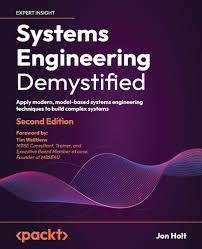White Paper on Systems Engineering
Introduction
Systems engineering is a structured interdisciplinary approach for designing, integrating, and managing complex systems throughout their life cycles. It ensures that all system components work together efficiently, effectively, and sustainably. By combining technical expertise, project management, and systems thinking, systems engineering is critical to solving today's multifaceted challenges across industries.
Core Principles of Systems Engineering
- Holistic Approach:
- Focuses on the system as a whole rather than individual components.
- Life Cycle Orientation:
- Encompasses all phases from conception, design, implementation, operation, and decommissioning.
- Interdisciplinary Collaboration:
- Encourages collaboration among various technical and non-technical disciplines.
- Iterative Processes:
- Incorporates feedback loops for continuous improvement and optimization.
- Requirements Engineering:
- Defines and manages stakeholder needs, system requirements, and constraints.
- Risk Management:
- Identifies and mitigates risks throughout the project lifecycle.
Methodologies
- V-Model:
- Emphasizes verification and validation at every stage.
- Agile Systems Engineering:
- Integrates agile principles for iterative development and faster delivery.
- Model-Based Systems Engineering (MBSE):
- Utilizes models to support requirements, design, analysis, and validation.
- Lean Systems Engineering:
- Focuses on maximizing value and minimizing waste in the system lifecycle.
Tools for Systems Engineering
- Requirements Management Tools:
- IBM Rational DOORS, Jama Connect.
- Modeling Tools:
- MATLAB/Simulink, Cameo Systems Modeler.
- Simulation and Analysis Tools:
- ANSYS, Simulink, Modelica.
- Project Management Tools:
- MS Project, JIRA.
Use Cases
- Aerospace and Defense:
- Example: Development of the F-35 Lightning II aircraft.
- Approach: MBSE for system integration and rigorous testing.
- Outcome: Enhanced system reliability and mission readiness.
- Automotive Industry:
- Example: Electric and autonomous vehicles.
- Approach: Systems engineering to integrate software, sensors, and hardware.
- Outcome: Improved safety, efficiency, and user experience.
- Healthcare:
- Example: Medical imaging devices.
- Approach: Incorporating user requirements and rigorous validation processes.
- Outcome: Reliable and user-friendly diagnostic tools.
- Energy Sector:
- Example: Renewable energy grids.
- Approach: Systems engineering for integrating solar, wind, and storage systems.
- Outcome: Efficient and resilient energy solutions.
- Infrastructure:
- Example: Smart cities.
- Approach: Integration of IoT, transportation, and energy systems.
- Outcome: Sustainable and efficient urban environments.
- Telecommunications:
- Example: 5G network deployment.
- Approach: Using MBSE to manage the integration of hardware and software components.
- Outcome: Optimized network performance and reduced deployment time.
- Manufacturing:
- Example: Smart factories.
- Approach: Systems engineering for integrating robotics, IoT devices, and production lines.
- Outcome: Increased productivity and reduced operational costs.
- Transportation:
- Example: High-speed rail systems.
- Approach: Applying systems engineering to ensure safety, reliability, and seamless operation.
- Outcome: Enhanced passenger experience and reduced environmental impact.
- Space Exploration:
- Example: Mars rover missions.
- Approach: MBSE and iterative testing to ensure the rover's functionality in harsh environments.
- Outcome: Successful deployment and operation on Mars.
- Cybersecurity:
- Example: Enterprise security systems.
- Approach: Systems engineering for integrating firewalls, intrusion detection systems, and encryption protocols.
- Outcome: Enhanced protection against cyber threats.
Benefits of Systems Engineering
- Improved Efficiency:
- Streamlines processes and reduces redundancy.
- Risk Mitigation:
- Identifies potential risks early in the lifecycle.
- Cost-Effectiveness:
- Reduces costs through better planning and resource optimization.
- Enhanced Quality:
- Ensures high-quality outputs that meet stakeholder expectations.
- Scalability:
- Facilitates the design of systems that can evolve with changing requirements.
Conclusion
Systems engineering is indispensable in managing complexity and ensuring success in multidisciplinary projects. Its methodologies and tools have been instrumental across industries, enabling the creation of innovative, reliable, and sustainable solutions.
References
- Blanchard, B. S., & Fabrycky, W. J. (2011). "Systems Engineering and Analysis." Pearson.
- INCOSE. (2015). "Systems Engineering Handbook: A Guide for System Life Cycle Processes and Activities." Wiley.
- Sage, A. P., & Rouse, W. B. (2009). "Handbook of Systems Engineering and Management." Wiley.
- Wasson, C. S. (2015). "System Engineering Analysis, Design, and Development: Concepts, Principles, and Practices." Wiley.
- International Council on Systems Engineering (INCOSE). https://www.incose.org/
- NASA Systems Engineering Handbook. https://ntrs.nasa.gov/
- MIT OpenCourseWare. "Engineering Systems Division." https://ocw.mit.edu/
- IEEE Standards Association. "IEEE 15288: System Life Cycle Processes." https://standards.ieee.org/
- Schmidt, D. C. (2006). "Model-Driven Engineering." IEEE Computer, 39(2), 25-31.
- Buede, D. M., & Miller, W. D. (2016). "The Engineering Design of Systems: Models and Methods." Wiley.
- MathWorks. "Model-Based Design." https://www.mathworks.com/
- ISO/IEC/IEEE 29148:2018. "Systems and Software Engineering – Life Cycle Processes – Requirements Engineering."
- Eppinger, S. D., & Browning, T. R. (2012). "Design Structure Matrix Methods and Applications." MIT Press.
- Pyster, A., & Olwell, D. H. (2019). "The Guide to the Systems Engineering Body of Knowledge (SEBoK)." https://sebokwiki.org/
- Larson, W. J., & Kirkpatrick, D. (2009). "Applied Space Systems Engineering." McGraw Hill.
Let me know if additional sections or more specific case studies need to be included! Contact ias-research.com for details.



